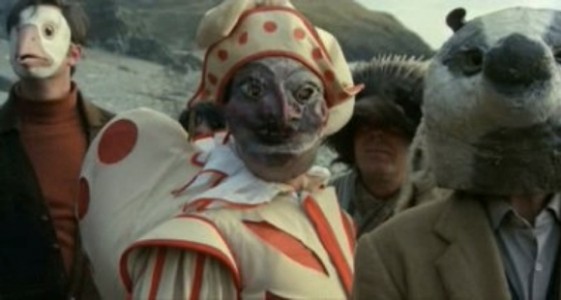
(Fig 1)
The British aren't known for creating hit films that win awards, especially horror films. One of the view films that are among the most recognizable, however, is Robin Hardy's 'The Wicker Man'.
(Fig 2)
Even from the first scene in the movie, a plane soaring above the seemingly uninhabited Hebrides islands as we listen to the sounds of folk music, it is apparent that this is not your conventional horror movie. It won't take place within the dim light of night time, but will in fact be played out in the grey skies of the British daytime. Sgt, Neil Howie, the apparent protagonist in this film, is a man flying to his death. When he arrives to the isolated island of Summerisle, he is to look for a child that had gone missing. Almost immediately after arrival, he is bombarded with the concept of paganism. Ye' olde medical cures such as a child holding a frog in their mouth to cure a sore throat, nude girls dancing and prancing in the nude over the fire as a fertility ritual and the daughter of the landlord dancing about her bedroom naked. (Fig 2)
The significance of her character is apparent when the film gives us a scene of sexual desire for her by the cop on the other side of the wall as he clings to it for dear life. After meeting the 'ruler' of the isle of Summerisle, a man with the last name of the same name, Howie is mortified that the isle's people seem to have outright rejected Jesus in turn for the worship of Gods of old. The cop then comes to terms with all the clues found: the girl must be the sacrifice and has been hidden away in preparation. However, it is eventually revealed that the sacrifice is not her, but him.
Hardy's famous film throws in all kinds of appealing, yet disturbing aspects of horror; the images of wooden horses, the puppet, Punch and maypoles are familiar to us due to having been part everyone's childhood at some point or another. The uncanny comes into play here as each one of these aspects are distorted in one way or another to turn them into some kind of horrible realization of what was lurking beneath all along. The Wicker Man seems to take inspiration from the works of Heironymus Bosch through the use of surreal imagery.Peter Bradshaw from The Guardian Magazine discusses this by stating: “The breast-feeding woman holding an egg in the ruined churchyard is like a detail from Hieronymus Bosch. And that final sequence, with the eponymous Wicker Man, is inspired.” (Bradshaw, 2007) Quite rightly said, he states that these scenes are almost as if they had been taken directly out of a Hieronymus Bosch painting.
(Fig 3)
The Wicker Man displays strong elements of confliction in religions through the use of Mr. Summerisle and Howie. Both of them are under the impression that they are in the right, yet none of the two are able to see the world view from the other's perspective. The film, however, displays these views to significant depth through its course. Steven D. Greydanus gives more of an insight on this subject, stating: “The double vision persists to the end: The pagans are gay and pleasant and wily; the pagans are degenerate, monstrous, insane. Howie is a fool, a sourpuss, a prude; Howie is an unlikely saint, a prickly victim soul.” (Greydanus, 2006) Greydanus presents us with the aspects of these two sides a little more clearly, stating that the pagans are cheerful and pleasant, but are also savage and mad while stating that Howdie, while an unlikely saint and a victim, he is also prude and sour. In a way, both sides are as bad as each other, but have their respectful aspects.
(Fig 4)
At the end scene of the film, the singing villagers sway from side to side around the burning wicker man in praise to their deities of the earth and sea and Howvie, trapped inside the burning chest of the wicker man shouts to them and preaches the word of God. This is one of the most famous scenes in cinema due to its horrifying nature. The end scene of the wooden figure's burning head breaking away from its body into the sunset gives the audience no comfort, either. (Fig 4)
BIBLIOGRAPHY:
IMAGERY:




This comment has been removed by the author.
ReplyDelete